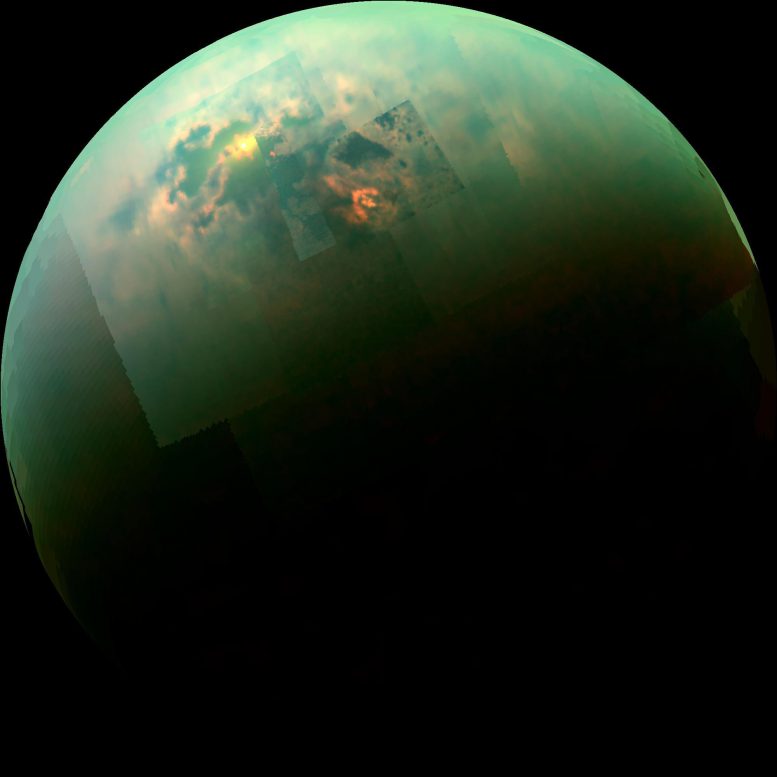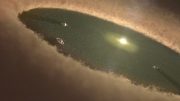A new three minute video uses data collected by Cassini’s imaging cameras and the Huygens Descent Imager/Spectral Radiometer to better detail Saturn’s moon Titan.
Approaching Titan a Billion Times Closer
Remember the Titan (Landing): Ten years ago today, January 14, 2005, the Huygens probe touched down on Saturn’s largest moon, Titan.
This new, narrated movie was created with data collected by Cassini’s imaging cameras and the Huygens Descent Imager/Spectral Radiometer (DISR). The first minute shows a zoom into images of Titan from Cassini’s cameras, while the remainder of the movie depicts the view from Huygens during the last few hours of its historic descent and landing.
It was October 15, 1997, when NASA’s Cassini orbiter embarked on an epic, seven-year voyage to the Saturnian system. Hitching a ride was ESA’s Huygens probe, destined for Saturn’s largest moon, Titan. The final chapter of the interplanetary trek for Huygens began on 25 December 2004 when it deployed from the orbiter for a 21-day solo cruise toward the haze-shrouded moon. Plunging into Titan’s atmosphere, on January 14, 2005, the probe survived the hazardous 2 hour 27 minute descent to touch down safely on Titan’s frozen surface. Today, the Cassini spacecraft remains in orbit at Saturn. Its mission will end in 2017, 20 years after its journey began.

This near-infrared, color mosaic from NASA’s Cassini spacecraft shows the sun glinting off of Titan’s north polar seas. The sunglint, also called a specular reflection, is the bright area near the 11 o’clock position at upper left. This mirror-like reflection, known as the specular point, is in the south of Titan’s largest sea, Kraken Mare, just north of an island archipelago separating two separate parts of the sea. This particular sunglint was so bright as to saturate the detector of Cassini’s Visual and Infrared Mapping Spectrometer (VIMS) instrument, which captures the view. It is also the sunglint seen with the highest observation elevation so far — the sun was a full 40 degrees above the horizon as seen from Kraken Mare at this time. Because it was so bright, this glint was visible through the haze at much lower wavelengths than before, down to 1.3 microns. The southern portion of Kraken Mare (the area surrounding the specular feature toward upper left) displays a “bathtub ring” — a bright margin of evaporate deposits — which indicates that the sea was larger at some point in the past and has become smaller due to evaporation. The deposits are material left behind after the methane & ethane liquid evaporates, somewhat akin to the saline crust on a salt flat. The highest resolution data from this flyby — the area seen immediately to the right of the sunglint — cover the labyrinth of channels that connect Kraken Mare to another large sea, Ligeia Mare. Ligeia Mare itself is partially covered in its northern reaches by a bright, arrow-shaped complex of clouds. The clouds are made of liquid methane droplets, and could be actively refilling the lakes with rainfall. The view was acquired during Cassini’s August 21, 2014, flyby of Titan, also referred to as “T104” by the Cassini team. The view contains real color information, although it is not the natural color the human eye would see. Here, red in the image corresponds to 5.0 microns, green to 2.0 microns, and blue to 1.3 microns. These wavelengths correspond to atmospheric windows through which Titan’s surface is visible.
Image: NASA/JPL-Caltech/University of Arizona/University of Idaho









Be the first to comment on "New JPL Video: Approaching Titan a Billion Times Closer"